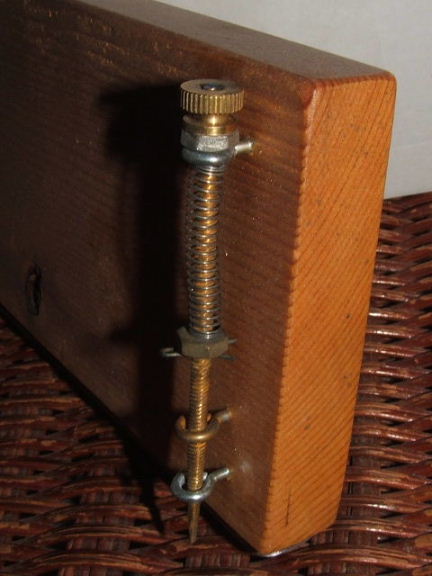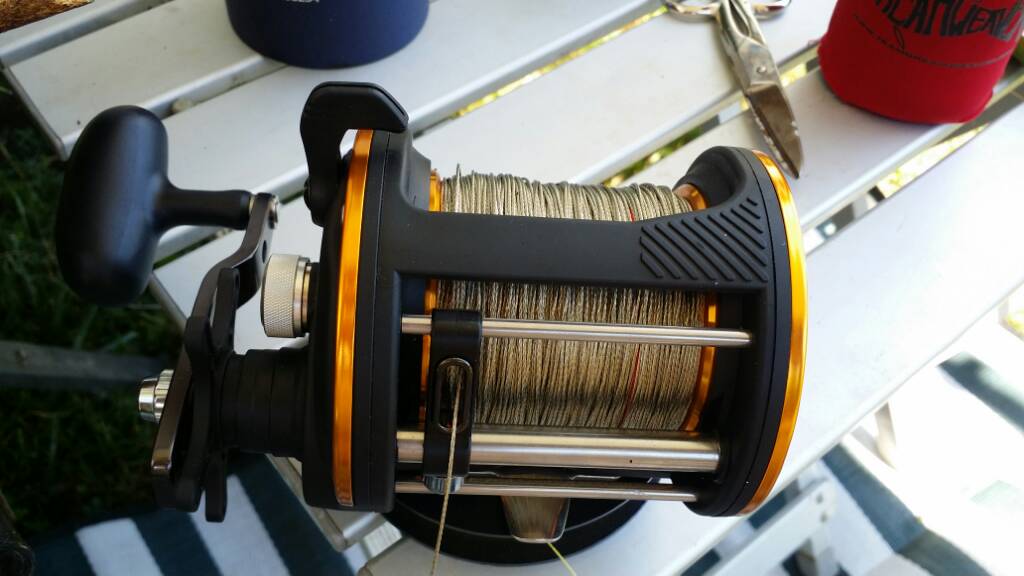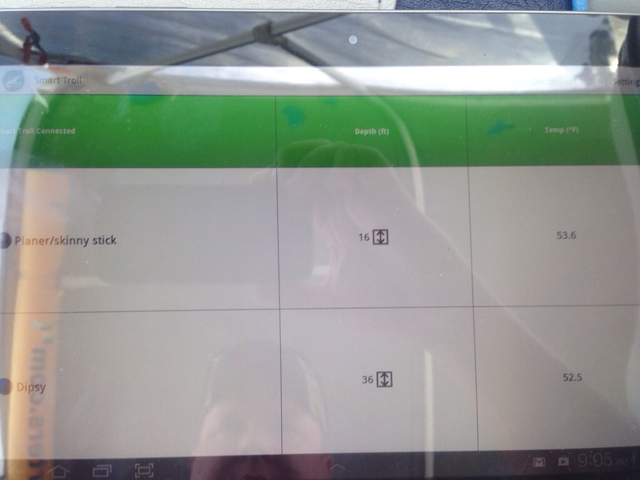

bloodrun
Members-
Posts
47 -
Joined
-
Last visited
Profile Information
-
Gender
Not Telling
Recent Profile Visitors
The recent visitors block is disabled and is not being shown to other users.
bloodrun's Achievements
0
Reputation
-

Four wire diver rods on L.O.-is it worth it?
bloodrun replied to Mike M's topic in Questions About Trout & Salmon Trolling?
Aside from being the most productive rods in the water for us for more than a decade, wire divers tell us so much more about what currents are doing as well, and create a harmonic that cannot be duplicated by any other presentation. I would run down the dock in a thong before NOT running 4 wire divers (sometimes 6) at all times. Spinnies and flies on all of them from June through September. -
we used to think it was the be-all end all. Still have one and run it once in a while. Once we figured out how to catch kings in 70 degree water and read our speed watching our wire divers, we stopped relying upon it. Nice to know information, not need to know unless maybe you are tournament fishing and need to keep up with a moving pocket of down water that is holding fish you are fishing for.
-
Even with OR-18's or Lock Jaws..eventually line will slip, particularly braid. We switched over to metal pins in the back of all our Church's and now when we put the line behind the pin, we spin the entire board around two or three times before we put the line in the release. In the event the line comes out of the release, the board stays on the same place on the line. Additionally, the board will never again slip down the line because of the line slipping through the release. The "spin on the pin" keeps it stationary. Won't work on stock pins as the line will cut a groove in the plastic and you cannot pull the pin up when you are bringing a board in. Have heard good things about the Offshore Snapper Adjustable tension release, but again, any line will eventually cut through the rubber pads and your line will no longer hold inside the release.
-
We have used quite a bit of 32, 45 and 60lb...The majority of what we use now is back to all 32lb (which is where we started many years ago). We have a couple of 200' 60lbs which are by far our best overall, but you can't beat the smooth deployment and greater capacity of the 32lb. If you keep your boards spaced out good, you should have no problem mixing different copper sizes. We use all Church walleye boards with the weight pushed forward for our 35'-150' coppers. Everything from 200' and beyond gets a Church TX-44 with the weights pushed forward also. Our boards get out real wide with great spacing, even on super long meat rig paddled setups 500+. We typically run 4 boards a side and have started loading up with multiple reels of the same segment. Fishing is getting a little tougher the past year or two, and when fish are biting on a certain length, we will put out 4 to 6 of them at a time. It has paid huge dividends.
-
From what I have seen, you still have to deploy the same amount of line to get to the depth you want. The only difference is instead of letting out 300 feet of copper and reaching your depth, you would let out 200 feet of copper, 100 feet of backer, and then snap this thing on and they say you would be at the same depth. In my experience these work good running lots of shallow lines trolling for walleye, like the top 20 maybe 30 feet. Once you get deeper with long coppers, heavy currents, big paddles and flashers....they dont work and they tangle like crazy with gear next to it. They get dragged around in the current and will inevitably swing into nearby coppers or divers.
-
Blood Run
-
There are some tricks to the TX-44, and inlines in general. For all inlines, fighting a fish should have the rod pointed horizontally or into the water. Rod tip down, board nose up.....right up to the point that you lift the board out of the water. There is no pumping of inlines, just brute force shoulders down reeling. You actually are using the board for leverage against the fish. Second tip (for the TX-44). You HAVE to put the pin on the bottom, and clip your line in the bottom slot. These boards are designed to be either port or starboard. In either case, you have to use the bottom slot for your line, and the pin must pull down towards the water. Third tip on the TX-44. Take the weights out of the board, cut a slot in the foam which will allow you to double stack the weights slightly forward of center. Drill new holes in the bottom through the stacked pieces of lead, and screw the screws back into these stacked pieces. Your TX-44 will now pull 30 degrees further up the side of your boat then they previously did, and will pull much more effortlessly, and will be easier to retrieve. If for some reason you have an inline board dive, stick the rod tip into the water and open the bail on the reel and slowly allow line to peel off the reel while thumbing it. The board will quickly pop back up to the surface. Re-engage the bail and start your retrieve again, with your rod tip pointed into the water.
-
Don't be afraid to use inlines. Here is a picture of our spread with the three outside coppers on Walleye Boards, and two closest coppers on TX-44's. We have not had to fish super deep this year, but in years past this same spread can be run with 450-600's, however only using TX-44's. http://instagram.com/p/qBrfCFHlWt/?modal=true
-
We have had pretty extensive useage of the system, and while not perfect, it does what it intends to do. Probably the only issue that we have on occasion is RPM interference on the signal. But, we are trolling a 454 with bags on both sides of the boat and are pushing 1000 rpms all the time. When we drop a bag, and troll with the motor on the opposite side of the boat that the transducer is mounted, we get flawless readings (under about 700 rpm). You have to get use to the numbers "settling in". The new upgrade to the probes increases the communication frequency between probe and transducer, so you wait less time for updated readings..a few seconds instead of sometimes several. The information provided however cannot have a price put on it, extremely valuable in our opinion. The technology will only get better, and yes Darrell is behind it 100%. Great guy and great customer service.
-
Blood Run Tackle, LOU site sponsor as well. Also selling pre-loaded Tekota's (and other reels) on their website at http://bloodruntackle.gostorego.com/salmon-fishing-line-downrigger-leader-wire-copper-trolling/pre-spooled-shimano-tekota-800-copper-fishing-wire-line.html
-
http://www.bloodruntackle.com/wp-content/uploads/2013/05/CopperDiveChart.pdf and the android app http://www.bloodruntackle.com/BloodRunTackle.apk Should give you a rough idea at least up to 2.5 gps speed. Alot depends on down speed/currents also. These numbers are with a spoon only.
-
Not at the moment, as discussed above 3.0 is way out of most guys comfort zone for walleye, though it is deadly! I will ask and find out if there are plans, there are a number of folks coming out of the closet regarding fishing at those higher speeds, even spinner guys! The walleye copper is fairly small diameter and that may help against "lift" at higher speeds compared to larger dia lines (core, 45lb copper, etc).
-
Have caught alot on lead too..but we have far more success now with copper. Just reporting what we saw with the smarttroll and fishawk td. There were numerous other folks that saw the same thing. We did stop once and lead finally sunk. Does not even come close to the sink rate of copper though. Here are the leadcore numbers at 2.5 gps with a spoon in the first column. Second column is Walleye copper depths at the same amount of line out also with a spoon. 2.0 speed number are even more dramatic. Copper is heavier than lead by a wide margin. 1 color - 2' - 4' 2 color - 7' - 9' 3 color - 9' - 14' 4 color - 11' - 17' 5 color - 14' - 22' 6 color - 18' - 28' 7 color - 21' - 34' 8 color - 24' - 38' 9 color - 29' - 43' 10 color - 37' - 51' Leadcore flatlined from 10 to 20 colors....approx 37 feet the whole way out at 2.5 gps. Copper kept on sinking. Same measurement tool was used for both.
-
Blood Run is testing a 20lb version of the Sea Flee line this season, as well as introducing a new "Niagara Green" color in June (in 30lb test). This line did the trick last year on Lake O and the Finger Lakes. Be sure to wrap 7 times on a Blacks release...the line is pretty slick. The line could be difficult to get ahold of for a while, Narby's, All Season's and Fat Nancy's are the only dealers in stock at the moment.



